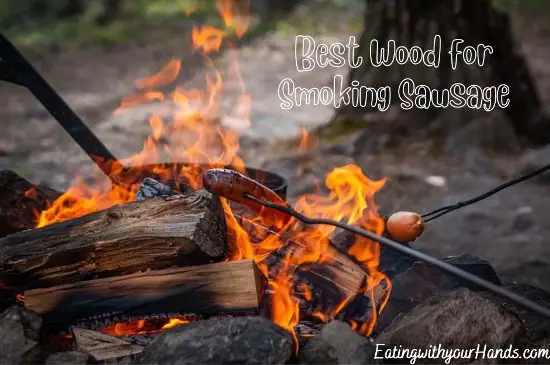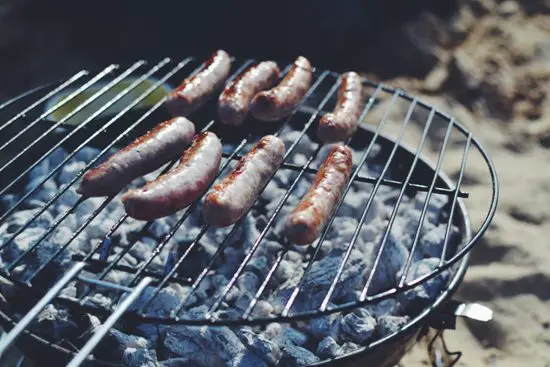Smoked sausage is a delicious addition to any meal, thanks to its rich, smoky flavor. This distinct taste is achieved through the process of burning wood chips during smoking, which infuses the meat with its signature aroma.
While making smoked sausage is relatively easy and quick, choosing the right woods is crucial to achieving the best results.
You may already be familiar with popular woods like hickory, mesquite, oak, cherry, apple, acacia, pecan, and peach, it’s important to know which woods to choose for specific meats to achieve their distinct flavors.
In this article, we will explore everything you need to know about selecting the best wood for smoking sausage.

Table of Contents
Different Types of Wood for Smoking Sausages Based on Meat Varieties
The choice of wood is of paramount importance. Each type of wood boasts a unique aroma, with some being more pungent and others exuding stronger, sweeter scents. Your sausage will adopt the fragrance of the wood, making it essential to be attentive to the aroma.
Utilizing high-quality wood is essential in crafting a truly delectable sausage. Various wood types can be employed, and among the popular choices is hickory.
However, the choice ultimately depends on personal preference and taste. If you prefer a robust yet mellow flavor, try using hickory wood.
It is recommended to avoid using cherry wood if you don’t want your sausage to be too sweet.
Read the following sections to learn more about each type of wood.

Hickory Wood
Hickory is highly favored for adding flavor to sausage because of its sweet yet intense taste, which brings to mind the richness of bacon.
It has a slow-burning, high-temperature quality that infuses foods with hearty and substantial flavors. It’s a good choice for enhancing the taste of pork shoulders and ribs.
When it comes to using hickory for flavoring sausage, it’s ideal for those bigger cuts of meat like Texas-style beef briskets, entire chickens or turkeys, and even wild game.
However, note that using too much hickory on smaller pieces of meat or poultry may result in a bitter flavor and cause the meat to burn.
Additionally, hickory is more potent than fruit woods. Hickory isn’t highly resistant to mold or water, so it’s best to avoid using it in damp or humid environments.
Apple
If you’re searching for a wood that can enhance the sweetness of your sausage, applewood is an excellent option.
It can provide that sweet flavor that everyone is talking about, but it’s also mild enough to use on lighter dishes like poultry, fish, and even pork.
Keep in mind that this wood requires several hours to infuse the smoke flavor into the meat, so plan accordingly if you’re preparing for a family gathering or a short party.
Also, since this wood is best suited for lighter meats and poultry, it’s recommended to use small pieces to ensure proper cooking. If you use a large piece, it may take longer to cook thoroughly.
Mesquite Wood
Mesquite wood is produced from small, prickly trees of the pea family called Prosopis. Its strong flavor can overpower meats like chicken, pork shoulder, ribs, and fish with a mild flavor.
However, it’s a popular smoking wood for barbecue in southwest Texas as it’s slow-burning and perfect for grilling and sausage smoking.
It’s not ideal for all types of meat, such as wild game, beef brisket, duck, and lamb. Using smaller, lighter pieces of meat or chicken is recommended, as larger chunks don’t impart much flavor.
Oak
When cooking beef or lamb, oak is the ideal hardwood to use. It is also versatile enough to be used with chicken or pork, providing a rich flavor and light brown color to the meat or poultry.
Oak is excellent for all red meat, providing both heat and flavor, making it an excellent choice.
Despite being a powerful wood, oak does not overpower the flavor and texture of the meat. It is perfect for large cuts of meat.
Cherry Wood
If you’re looking to give your smoked sausage a sweet and fruity flavor with a reddish hue, cherry is a good choice.
When combined with hickory, it creates a delicious and strong aroma. Cherry has a mild and sweet taste that goes well with chicken, small game birds, lamb, pork, and sausage.
Acacia
Acacia, related to mesquite, offers a milder flavor than its stronger cousin. Thanks to its lighter taste, acacia ranks among the top choices for smoking wood for meat and imparts a light yellowish hue.
Pecan
Pecan wood is a popular and good choice among barbecue enthusiasts because it pairs well with various types of meat.
Its slow-burning nature makes it ideal for long barbecue sessions, and it imparts a subtle flavor to the meat.
Pecan wood can be used to smoke not only chicken, but also lamb, brisket, ribs, ham, pork loin, and more.
Peach Wood
Peach wood has a slightly sweet and light taste, which is typical of most fruitwood. If you want to add a fruity flavor to your smoked meat, fruitwoods are an excellent choice.
You can combine peach wood with hickory or mesquite wood to add more savory flavor to your sausage.
Wood Types to Avoid
Softwoods like Cyprus, sycamore, pine, cedar, fir, sassafras, elm, and eucalyptus should be avoided at all costs because they can transfer unpleasant odors and even make you ill.
Instead, stick to hardwoods to get the best flavor and aroma.
Dry Wood or Wet Wood
Which is better, dry wood or wet wood? When it comes to using wet chips or sawdust, the debate has raged on. Many believe that wet wood generates more smoke, but here’s the twist: that extra smoke is actually a combination of water vapor (steam) and smoke.
This detail becomes crucial when you’re engaging in hot smoking within the temperature range of 105-140°F (40-60°C), especially for shorter durations. The added moisture plays a pivotal role in preventing sausage casings from drying out while infusing them with that delectable smoky flavor.
However, hold on a moment – those wet wood chips won’t stay damp forever. The heat eventually gets to them, causing them to dry out.
Initially, these damp chips release a pleasant smoke and might even help lower the temperature slightly. But beware once they’ve dried!
They’re prone to catching fire, sending the temperature soaring. And guess what comes next? The grease from the smoke sausages drips onto the flames, transforming into a fiery spectacle.
Now, if you’re working with a smoker equipped with a separate fire pit, you’ve got more flexibility. You can burn larger wood chunks since the flames they generate won’t invade the smoker itself.
And remember, during cold smoking, it’s best to steer clear of wet wood. Cold smoking revolves around eliminating moisture, not inviting it in. The goal is to gently warm the meat’s surface, coaxing any moisture to vanish.
Using wet wood for a two-day cold smoking session won’t effectively dry out the meat.
However, when you switch gears to hot smoking, the dynamics change. The harmonious interplay of smoke and air collaborates to desiccate those casings, giving them a more robust texture. This principle extends to the meat’s surface, which becomes notably drier.
Thus, during hot smoking, deploying wet wood actually introduces a modicum of moisture to the product’s exterior, lending a helping hand to the process.
Basically, whether you choose wet or dry wood depends entirely on your goals when it comes to the world of barbecue.
Best Woods For Smoking Summer Sausages

The ideal wood-to-smoke summer sausage is a mix of hickory and cherry wood chips, as they offer the perfect blend of robust and fruity flavors.
You can also opt for plain hickory, mesquite, or oak if you prefer a stronger flavor.
When selecting the wood, it’s essential to choose one that you enjoy the smell of. If you find cherry too mild and mesquite too overpowering, hickory might be the best option for you.
>>Also Read: Do You have to Cook Summer Sausage? and How to cold smoke sausage?
Best Wood for Smoking Venison Sausage
All of these wood types are great for enhancing the flavor of venison.
Combining a stronger wood with fruit, such as cherry or apple, can help bring out its full potential. Additionally, adding a little sugar or sweetener to the strong-flavored venison can improve the overall taste.
Mesquite, being the strongest hardwood in terms of flavor, could be a good option for those who prefer a bolder taste.
Best Woods for Smoking Italian Sausages
Hickory is undoubtedly the top choice smoking wood when it comes to Italian sausage. A three-hour smoking session with hickory will give the sausage a slightly reddish hue and an internal temperature of 165°F, resulting in a perfect taste.
However, since hickory has a strong flavor, it should be used in moderation. To tone down the intensity, you can mix it with fruitwoods such as apple or cherry.
In case you don’t have hickory on hand, oak can be used instead, especially if you have leftovers from the previous session.
Remember that any hardwood tree can be used to smoke Italian sausage, but it is always best to choose one that suits your personal preferences and taste.
>>Read more about: Salami with black spots.
Best Woods for Smoking Polish Sausage
When it comes to selecting the best wood for smoking Polish sausage, hickory and cherry emerge as the top contenders, each contributing to its delectable flavor profile.
What’s even more exciting is that hickory offers various options – whether you prefer using actual wood, sawdust, or convenient wood chips. Here’s a tasty tip: enhance the flavor by blending in a touch of cherry with your hickory.
Now, if you’re aiming for that delightful sweet aroma in your sausage, cherry is the go-to choice.
And for those new to the world of smoking Polish sausage, fear not. Oak is your trusted companion. It serves as the ultimate sidekick for smoking all types of meat.
Conclusion
Out of all the types of wood mentioned in this post, hickory and cherry are the two safest bets for beginners in smoking sausage.
Oak can also be added to the list of best smoking wood for novices.
If you prefer a bitter or pungent taste, mesquite may be a better option than cherry or some other fruit woods that have a sweet flavor.
You can also experiment by mixing and matching different types of wood to find the perfect combination.
In general, it’s advisable to stick to hardwoods or medium hardwoods and avoid softwood. Ultimately, the choice of wood comes down to personal preference.
>>Related Post: Best Types of Sausages for Smoking

Fernando is the creator and writer behind the food blog Eating with your Hands. Living and working in cities like Paris, Barcelona, and Berlin, and being married to a Canadian foodie, has given Fernando a passion and interest in food and inspired him to run EWYH.
